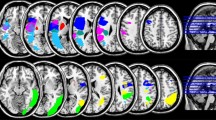Abstract.
In a previous study, we demonstrated that the time-course for amplitude specification of goal-directed aiming movements is similar for individuals with and without a unilateral sensorimotor (SM) area lesion. However, subjects with a SM lesion performing with the arm ipsilateral to the side of the brain lesion were significantly less accurate than control subjects in an unpredictable condition. The unpredictable condition requires that subjects both formulate an initial plan for movement as well as adjust the response later as additional information about the target (i.e., the goal) is gained. It has been demonstrated that premovement planning and compensatory adjustments are the processes contributing largely to accuracy in targeted, isometric force responses. A statistical model has been described, which partitions response trajectories into the planned and compensatory adjustment components. The purpose of this study was to apply the statistical model to our previous data to determine if the difference in accuracy in those with unilateral stroke was due to a deficit in premovement planning, compensatory adjustments, or a combination of these two factors. We compared the performance of six subjects with unilateral stroke to that of matched control subjects participating in a timed-response movement paradigm. Subjects rapidly flexed or extended the forearm in order to capture a short (20°) or long (45°) target presented in either a fixed (predictable condition) or a random sequence (unpredictable condition). For individuals with stroke, the limb used was that ipsilateral to the side of the SM lesion. Time to prepare the response was manipulated by varying the time of target presentation relative to an auditory cue for movement initiation. Velocity was derived from the displacement data, and multiple regression was used to determine the effect of premovement planning and compensatory adjustments on end-point accuracy. In the predictable condition, premovement planning contributed to final position more for the subjects with stroke [mean (SEM) =0.50 (0.02)] than for the control subjects [0.36 (0.03)]. In the unpredictable condition, there were no differences between groups in percent variance due to planning [0.54 (2.1) for the stroke group and 0.45 (2.8) for the control group]. This suggests that the ipsilateral (i.e., intact, undamaged) SM hemisphere significantly participates in the premovement planning of an aiming action. In contrast, for both predictable and unpredictable conditions, compensatory adjustments accounted for a smaller percentage of the variability in final position for the subjects with stroke than for the control subjects [0.09 (2.2) for the stroke group and 0.25 (4.8) for the control group]. Therefore, the less accurate responses for the stroke group can be explained by deficits in the compensatory adjustment component. This suggests a substantial role for SM areas in the preparation and implementation of corrective actions while the effects of the pre-planned action are unfolding. In particular, we discuss the role of the ipsilateral SM areas in relation to parallel feedforward processing in unimanual aiming.
Similar content being viewed by others
Author information
Authors and Affiliations
Additional information
Electronic Publication
An erratum to this article is available at http://dx.doi.org/10.1007/s002210000391.
Rights and permissions
About this article
Cite this article
Fisher, B., Winstein, C. & Velicki, M. Deficits in compensatory trajectory adjustments after unilateral sensorimotor stroke. Exp Brain Res 132, 328–344 (2000). https://doi.org/10.1007/s002219900316
Received:
Accepted:
Published:
Issue Date:
DOI: https://doi.org/10.1007/s002219900316




